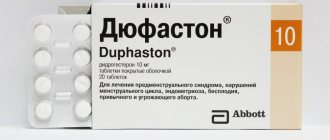Properties and effects of ascorbic acid on the body
Delayed periods can occur for many reasons. The main ones:
- heavy physical activity;
- stress;
- diet;
- nervous system disorders.
Regardless of the factor that contributed to the occurrence of problems in the female body, the girl should begin to worry about this after a week of the expected date of the onset of menstruation. After this, you need to contact a gynecologist to solve the problem. Ascorbic acid can be prescribed by a doctor to eliminate a delay in menstruation, but such decisions cannot be made at home.
Vitamin C, present in ascorbic acid, helps improve metabolism, eliminate hormonal imbalances, strengthen vascular walls, and also cleanse the blood of excess cholesterol.
Taking vitamins helps regulate the menstrual cycle, but the speed of this is not great - complex treatment takes 2-3 months. This time is necessary to restore vitamin C deficiency in a woman’s body.
However, too much of it can delay the onset of the cycle, and therefore requires consultation with a gynecologist. The effect of ascorbic acid on a woman’s body may not be noticeable, as organ function is normalized.
Vitamin complexes to normalize the cycle
Vitamins Cyclovit
There are ready-made preparations for restoring the “female calendar”. The leader among them is Cyclovit. It includes “Cyclovit 1”, which is used in phase 1 and “Cyclovit 2”, used in phase 2. The composition has a variety of vitamins collected in a certain ratio.
The drug does not contain hormones, but thanks to the components it contains, it improves hormonal levels.
As a result:
- well-being improves;
- relieves pain during menstruation;
- soreness of the mammary glands decreases;
- the cyclicity of menstruation is restored;
- the functioning of the reproductive system is normalized.
How does it affect menstruation?
Ascorbic acid affects the production of estrogen and progesterone, and also normalizes FSH, so menstruation does not take long to arrive. Once the balance is restored, the cycle will work like a clock.
Vitamin E must be present in the female body in sufficiently large quantities, as it affects the functioning of the reproductive system. Menstrual discharge is the endometrium from the inner cavity of the uterus, which is separated due to the absence of pregnancy. Obviously, for a normal cycle it is necessary to maintain the health of the pelvic organs.
Ascorbic acid helps accelerate the synthesis of the essential vitamin, which is beneficial for the body when menstruation is delayed. Usually the necessary vitamins come from the food we eat, but not always in sufficient quantities, and therefore their content needs to be increased.
Blood is the main component of menstrual flow, and therefore it is necessary to normalize its composition. If it is viscous, then menstruation may slow down. This is affected by a large amount of cholesterol. Vitamin C helps thin the blood, but it is not recommended to use a loading dose right away, as this can only cause harm.
The benefits of ascorbic acid during delay
When answering the question whether vitamin C can cause menstruation, it should be noted that this only works in certain situations.
Ascorbic acid eliminates the delay that was caused by the following reasons:
- Minor hormonal imbalance.
- Consequence of severe stress.
- Improper or incomplete absorption of vitamin E.
- Exhaustive diets.
Against the background of pathologies of the genital organs, a serious lack of female sex hormones and thyroid diseases, the effect of the drug is minimal. There is a possibility that the patient’s general condition will improve, but there will be no menstruation until the provoking disease is eliminated.
Signs of vitamin deficiency
The body always shows with the help of certain signs that it lacks something. It is necessary to pay attention to such symptoms in order to eliminate them in advance, without suffering from this problem in the future.
Only a specialist can find out what exactly caused the lack of vitamin C in a woman’s body, so you need to visit a gynecologist after identifying some of the symptoms. Sleep disturbances may occur, and throughout the day there is often a feeling of anxiety for which there is no reason.
The skin itself becomes very pale, and it seems that the first symptoms of the flu appear, as the body’s protective functions weaken. But if all this can be attributed to ordinary symptoms, then if they appear along with bleeding gums and pain in the heels and feet, you should check the level with a doctor.
At the same time, there is no possibility that the body lacks this particular vitamin, since there may be other reasons for delayed menstruation. Any hypovitaminosis is expressed by similar symptoms, but there is a distinctive feature - prolonged bleeding.
This is explained by the increased fragility of blood vessels, since the walls do not have enough collagen, the synthesis of which occurs under the influence of vitamin C. It can be characterized by the flow of blood from the nose, as well as the appearance of bruises at the slightest blow.
Possible causes of disruptions and delays in the menstrual cycle
Frequently encountered gynecological disorders include irregularities in the menstrual cycle. Sometimes this happens one-time, for example, as a result of stress, but if there are constant delays, it is worth finding the reason for the change in the biological rhythm.
Girls' first menstruation usually occurs between the ages of 12 and 13.5 years. From the moment of the first discharge, at least 8 discharges must occur during the year. They occur at different intervals, since the cycle has not yet been fully established. In the future, for each woman this is a strictly defined period - from 21 to 33 days. For each woman, this interval is individual, but limited by these numbers.
A normal menstrual cycle is characterized by:
- strict cyclicity and average duration up to 28 days;
- the course of menstruation for 5 days;
- blood loss during its course - 50-150 ml,
- no pain;
- feeling good before or after it.
Knowing your calendar, it's not hard to notice a delay. There are minor deviations in one direction or another for a few days, which is not a serious problem. But disruptions in the cycle, which has been stable for several years, are alarming. Changes in the duration of menstruation themselves should also not be ignored.
A significant reduction or increase in the menstrual cycle (by 10 days or more) is a reason to visit a gynecologist and find out the reason why the female calendar is disrupted.
Reasons for changes:
- Development of pathogenic microflora in the pelvic area. Chlamydia, uroplasia, mycoplasma and other microorganisms can multiply here. This problem can be solved and after treatment the monthly cycle is restored.
- Hormonal imbalances that occur for various reasons. After analyzing hormones, the doctor decides on a course of treatment, which will be long and not so simple. Finding the cause and correcting hormonal levels is a rather difficult task. Most often, the problem is related to the functioning of the thyroid gland or dysfunction of the adrenal glands.
- Impaired ovarian function, which affects the reproductive system as a whole, disrupting the normal course of menstruation. Treatment is possible if such failures are not hereditary.
- Rubella or chickenpox suffered in childhood leads to disruption of the formation of follicles in the ovary. Disruptions in the female cycle occur from the first menstruation, but people come to the doctor with this problem much later, which makes treatment difficult.
- Diet and intense physical activity. When a girl exhausts herself with hunger, “sits” on a protein diet, or, on the contrary, engages in bodybuilding, constantly increasing the load, this can lead to a complete absence of menstruation.
- Constant stress and psycho-emotional tension also cause disruptions in the women's calendar. But it is not necessary to go to the doctor with this problem. It is enough to eliminate the source of mental disorders, move more and, if possible, enjoy life.
If there is a significant delay, a baby may be born for the first time after 9 months. The reason for short-term changes in timing is any factor that makes changes in everyday life: moving to a new place, poisoning, poor “ecology”, uncontrolled use of medications, vitamin deficiency and other reasons.
Important! Sometimes menstrual irregularities are associated with serious pathologies: ectopic pregnancy, tumors of the ovaries or uterus of a benign and malignant nature, tuberculosis, the occurrence of a tumor in the brain.
Instructions for use
You need to know how much ascorbic acid you need to take to speed up the appearance of your periods, so as not to harm yourself. In this case, it is necessary to exclude the possibility of conception, since during pregnancy, vitamin C intake should be limited.
Many forums that specialize in how to induce menstruation with ascorbic acid recommend taking a loading dose of vitamins. The normal daily intake is considered to be a dose of up to 100 mg. To speed up menstruation, it is recommended to increase the single dose to 0.5 grams. If this does not help, the dose is increased to 2 g per day.
However, this can be very harmful to health, since a large amount of even beneficial substances causes disruption of systems and organs. Therefore, experts very rarely advise taking pills in such quantities.
Ascorbic acid is prescribed as an addition to the main treatment. Take daily according to instructions - 2 tablets three times a day. This helps restore the cycle, rather than causing menstrual flow as quickly as possible.
By-effect
When the drug is used correctly, no side effects occur. On the contrary, the body as a whole and its protective functions are strengthened. When consuming a huge amount of pills, acid can cause harm to internal organs and lead to diseases:
- Gastrointestinal tract. Vomiting, nausea, pain in the stomach and pancreas appear.
- Diabetes mellitus, since the substance promotes the production of glucose.
- Anemia. Ascorbic acid for menstruation is taken at the rate established by doctors. Excess acid prevents iron from being absorbed and reduces hemoglobin levels.
- Urolithiasis.
You should not assume that ascorbic acid is an absolutely harmless substance for menstruation. Its thoughtless use will not be able to normalize ovarian function or restore hormonal levels. And it can cause gastritis, the development of ulcers and other gastrointestinal diseases. You can induce menstrual flow and avoid delays in your menstrual periods with medications that are specifically designed for this purpose. Don't try to fix everything yourself. There are many reasons for the delay of critical days.
Overdose
Overdose is characterized by three conditions: heartburn, flatulence and nausea. At the same time, it is worth paying attention to the contraindications for use that any vitamin complexes have. Vitamin C should not be used if you have an allergic reaction, low hemoglobin levels, or diabetes.
It is recommended to use with caution for people with impaired excretory system functions, as well as high acidity.
With the right approach to treatment, the restoration of the menstrual cycle will go smoothly and without any complications. To do this, you just need to make an appointment with a gynecologist and follow his advice.
General recommendations
When menstruation is delayed, ascorbic acid is optimally absorbed by the body if the following rules are observed:
- The same amount of vitamin C should be ingested every day so that the body learns to accumulate the useful substance. The same rule applies to appointment times.
- It is forbidden to take vitamins on an empty stomach, otherwise the risk of irritation of the gastric mucosa increases. It is optimal to do this during meals or take the tablets immediately after a meal.
- It is necessary to eat potatoes, bananas and other starchy foods that can relieve the possible negative effects of acid.
- There are certain days when it is better to drink period acid. Doctors advise doing this from the twelfth to the twenty-sixth day of the cycle.
- A large amount of the substance does not give quick results, but only provokes side effects.
- Sunlight enhances the absorption of vitamin C, so you should take the tablets in the morning and afternoon.
Ascorbic acid is not an absolutely safe drug, so it is better to avoid self-medication. Various factors can cause a delay in menstruation, including pregnancy. Therefore, before starting therapy, it is necessary to consult a gynecologist. The specialist will find out what exactly is delaying menstruation, and whether there is any point in additional sources of vitamins.
Normal vaginal microflora
The vaginal flora is represented by a combination of beneficial and transient microorganisms that are in strict balance: under normal conditions, the beneficial flora significantly exceeds the opportunistic flora. Approximately 95-98% of all vaginal flora is represented by lactobacilli (Dederlein's daddies). It is lactobacilli that, by destroying glycogen, produce lactic acid, which provides an acidic environment in the vagina and protects it from infection.
All these representatives of the vaginal flora are in symbiosis with the human body, not causing harm to health, but, on the contrary, protecting it from disease. With the normal functioning of the microflora, the infection entering the vagina is neutralized due to the acidic environment.
The microflora of the genital tract is not the same at different periods of a woman’s life and reflects the influence of a complex of factors from both the external and internal environment. Even during one menstrual cycle, fluctuations in phases are detected. Thus, in the first days of the cycle, the pH of the vaginal environment rises to 5-6, which is associated with the breakdown of endometrial and blood cells, while the number of lactobacilli decreases, but the balance is maintained by an increase in facultative and obligate anaerobes.
Rules for the treatment of vaginal microflora disorders, video
There are a number of factors that influence the likelihood of an imbalance in the vaginal flora. Among them the following can be noted:
- Hormonal surges observed during pregnancy, breastfeeding, abortion, perimenopause, menopause, transition, irregular sex life. For example, many women ask their gynecologists about how to restore the vaginal microflora after childbirth, since due to hormonal changes the mucous membrane becomes excessively dry and irritated.
- Antibacterial therapy. One of the features of antibiotics is that they destroy not only harmful, but also beneficial microorganisms. Therefore, after taking these medications, it is important to restore the disturbed vaginal microflora. And remember: under no circumstances should you take antibiotics uncontrolled for a long time without consulting a doctor, as this can lead to dire consequences.
- Regular hypothermia. They affect the level of general and local immunity, undermining the body's defenses.
- Menstrual irregularities, the presence of inflammatory processes affecting the cervix or ovaries, polycystic ovary syndrome and other endocrine disorders.
- Insufficient hygiene of the intimate area. If you do not wash yourself regularly, do not change your underwear, used pads or tampons on time, there is a high probability of developing vaginal dysbiosis. Particular attention should be paid to the timely change of tampons during menstruation: this must be done every 2-3 hours, because otherwise ideal conditions are created for disruption of the vaginal microflora. You also need to wash yourself properly, directing the stream of water from the front and not from the back, since in the second case, intestinal bacteria may enter the vagina.
- Unreasonably frequent and thorough intimate hygiene. It is not recommended to do vaginal douching too often, and it is advisable to wash yourself only 2 times a day.
- Using inappropriate intimate hygiene products. For washing, it is necessary to use specialized gels and foams for intimate hygiene. They have a neutral pH level and do not cause symptoms of vaginal microflora disorders. You should also avoid using tampons and pads that contain dyes and fragrances.
- Hormone therapy. Taking hormonal drugs can cause disturbances in the vaginal flora, so hormonal therapy should be strictly under the supervision of a doctor.
- Using an intrauterine device for a long time, taking certain oral contraceptives.
- Promiscuous sex life, refusal to use protective equipment when having sex with untested sexual partners.
- Staying in an unusual climate. Often, a change in climate zones from cool to warmer becomes one of the reasons for the imbalance of microflora.
- Intestinal dysbiosis and other stool problems. Intestinal bacteria can penetrate the vagina due to improper intimate hygiene.
- Stressful situations and unbalanced nutrition. Stress undermines the body's defenses, making it more susceptible to infectious processes. An unhealthy diet rich in yeast products, alcohol and simple carbohydrates also leads to a weakening of local vaginal immunity.
An imbalance of the vaginal microflora can be asymptomatic or have certain signs. Symptoms include the following clinical manifestations:
- Atypical vaginal discharge. Most often they have a gray or white color and a characteristic fishy smell. The discharge may also be foamy.
- Itching and burning.
- Painful urination.
- Dry mucous membranes and swelling
- Pain during intercourse.
Tampons with medicines and folk remedies are used both at the initial stage of the disease and in the treatment of chronic ailments, as well as for postoperative recovery. Their use in the prevention of inflammation and infections is not uncommon. Recently, tampons designed to protect against unwanted pregnancy have become widespread.
All these are different types of funds; they should not be compared with those needed on critical days. You should not use hygienic tampons for medicinal purposes if they have been soaked in medicine. After all, they are designed to absorb fluid, and the task of therapeutic vaginal tampons is exactly the opposite. The vaginal mucosa is very susceptible, subject to both positive and negative influences.
Its contact with the medicine, thanks to the tampon, will provide a beneficial effect not only on this organ, but also on the entire reproductive system. It is also important that the product comes into contact with the cervix, which is also very sensitive, and in addition has a hole that allows useful substances to penetrate into the organ cavity.
Cervical erosion
This disease occurs in every second woman, because it occurs due to inflammation or injury, which does not escape many. Erosion is characterized by a change in the mucosal epithelium in any area of the cervix. The disease causes many unpleasant moments during vaginal sex, becomes a conductor of infections and over time can degenerate into a malignant tumor.
- Propolis. 10 g of the product is liquefied using a water bath, mixed with 200 g of butter for 15 minutes. After filtering the resulting liquid, soak a tampon and insert it into the vagina for half an hour. This is done once a day until recovery. For one-time use, 1 tsp is enough. mixture heated in a water bath;
- Tampons with sea buckthorn oil. This product is successfully used in the treatment of various ailments by official medicine and as a folk remedy in gynecology, due to the presence of a large number of vitamins, organic acids and trace elements, as well as biologically active components. The oil relieves pain, promotes wound healing, regenerates tissue, and relieves inflammation. Before using it for erosion, it is necessary to free the cervix from mucus. To do this, you need sterile gauze swabs, which are pre-moistened with warm water. After cleansing, a tampon soaked in sea buckthorn oil should be inserted into the vagina for 20 hours. Treatment should continue for 14 days.
- 10% salt solution. The tampon treated with it is kept in the vagina for 15 hours;
- Onions and honey. Fresh or melted product in a water bath is poured into the middle of the peeled vegetable. The onion is placed in the oven before baking. Treatment of erosion with tampons in which the resulting product is wrapped should last 10 days.
For the entire duration of these procedures, sexual activity should be excluded. At the end of the treatment period, it is necessary to be examined to confirm its success. If tampons do not help against cervical erosion, you should look for other methods.
A benign tumor of the uterus is characterized by severe bleeding. If they become alarmingly large, the woman is offered surgery. But while it is possible to do without it, you can try the vaginal method of therapy. Among the many, tampons for the treatment of uterine fibroids have proven themselves to be:
- Onion. A small part of it, the size of a tangerine slice, is spread with honey in the morning and left until the evening. It is then wrapped in a gauze swab and inserted into the vagina. Treatment helps reduce bleeding and reduce tumor size;
- With propolis. A piece of the product is placed inside a gauze swab and placed in the vagina at night for 10 days. Next you will have to take a 5-day break and conduct a second course of treatment. Such tampons for uterine fibroids contribute to its complete resorption or at least a significant reduction. Traditional medicine prescribes 5 courses of treatment.
Saline tampons are used in gynecology to get rid of one of the forms of this disease - fibroids. They are used in combination with the same compresses on the lower abdomen. The salt solution is made quite weak: 2 tsp. for 300 ml of heated water. This treatment is also used for uterine polyps and cysts. 10-15 procedures are enough.
Endometritis
The inflammatory process in the endometrium causes prolonged menstruation, abdominal pain, and infertility. The vaginal use of healing products, including those of natural origin, can help cope with it:
- Sea buckthorn oil. A cotton-gauze swab is soaked in it and placed in the vagina for the whole night. After 10 days, inflammation will decrease, as will pain;
- Aloe with honey. The pulp from the leaves of the washed plant, mixed with the product, is placed in a tampon. The product is used for 10 days, placing it in the vagina at night.
Official medicine actively uses tampons with dimexide for endometritis. The medicine is diluted with water 1:3, a cotton-gauze turunda is soaked in it and inserted into the vagina for 8-10 hours. This prevents the development of the inflammatory process and reduces pain.
Endometriosis
The growth of the endometrium outside the internal cavity of the uterus annoys a woman with pain, difficult periods during her critical days, and most importantly, can cause infertility. The disease is difficult to treat, sometimes requires surgery, but even after that it is characterized by relapses. Therefore, tampons for endometriosis can play a very beneficial role in getting rid of the disease if they are soaked in:
- A mixture of crushed eucalyptus leaves and olive oil (180-200 ml) with 20 calendula flowers, infused under a lid in a warm place for 21 days. The product is also used vaginally;
- A mixture of onions, honey and celandine juice. Before use, douching with calendula infusion is necessary. Tampons with onions are used quite often in gynecology, but you need to make sure that the juice in its pure form does not get on the mucous membrane, otherwise a burn is guaranteed. Therefore, as a rule, it is supplemented with other components.
Thrush
Before choosing the right medicine, you should definitely get tested to determine the types of bacteria that cause thrush. Drugs for restoring vaginal microflora, as well as the duration of treatment, must be determined by a specialist. When you have a specific purpose, you can purchase candles at a specialized point of sale or buy them from an online pharmacy and order targeted delivery. Prices for medications can vary significantly. Approximate cost of drugs from the group of inexpensive and expensive:
- Acylact – from 150 rubles;
- Nystatin – from 80 rubles;
- Ginesol – up to 300 rubles;
- Livarol – 400-600 rubles.
What medications should you not combine the use of acid with?
For treatment to be beneficial, you need to take other medications seriously.
Some medications lose their effectiveness under the influence of ascorbic acid, and the likelihood of side effects also increases:
- Oral contraceptives. If you take OK along with ascorbic acid, the latter absorbs the level of hormones, making birth control less effective. Therefore, it is necessary to take a break between doses - at least two hours.
- Salicylates. Simultaneous use with aspirin, diflunisal, acetisal can provoke crystalluria (the appearance of salt crystals in the urine).
- Alkaline water. Do not take pills with alkaline mineral water due to decreased absorption of vitamin C.
- Antidepressants. Not only does the effectiveness of the drug decrease, but the production of mexiletine by the kidneys is also disrupted.
It is also prohibited to combine ascorbic acid with products that contain:
- iron;
- caffeine;
- folic acid;
- B vitamins.
What products contain
High tocopherol content can be found in the following products:
Vitamin E is found in many foods.
- nuts;
- wheat (sprouted grains and germ oil);
- fruits;
- sunflower oil;
- bran;
- liver;
- cereals;
- dairy products.
In the second phase of menstruation, it is recommended to combine these products with foods rich in ascorbic acid. These are citrus fruits, cabbage, raspberries, currants.
Tests to determine the state of the vaginal microflora
Since the disease is often asymptomatic, many women learn about it only at an appointment with a gynecologist. If the doctor suspects that his patient is not healthy, he takes a urogenital smear to determine the vaginal microflora for laboratory tests. To obtain results, a smear examination with Gram staining can be used in accordance with European recommendations in accordance with the Hay-Ison scale or with the assessment of Nugent scores and the Russian recommendations of the national guide to gynecology - femoflora analysis (determination of DNA of microorganisms associated with bacterial vaginosis or assessment of microscopic characteristics vaginal biocinosis (Kyra classification).
A smear examination involves the analysis of squamous epithelium, gram-positive rods (including Dederlein rods), leukocytes, etc. As a result of the studies, a specialist can determine the composition and ratio of vaginal microflora, the presence/absence/intensity of inflammation, and also determine the reason for the occurrence dysbiosis
Taking an analysis to identify the ratio of beneficial and pathogenic microflora of the vagina requires certain preparation:
- It is necessary to abstain from sexual intercourse for 24 hours.
- Three days before the smear collection, you should avoid vaginal douching, the use of tampons, suppositories and other local remedies, and do not perform hygiene on the day of the test collection.
- After consulting with your doctor, it is advisable to refrain from taking antibacterial drugs for at least a few days.
Test results can usually be obtained after 1-3 days, after which it is necessary to begin appropriate treatment aimed at restoring, improving and maintaining the vaginal microflora in a normal, healthy state.










